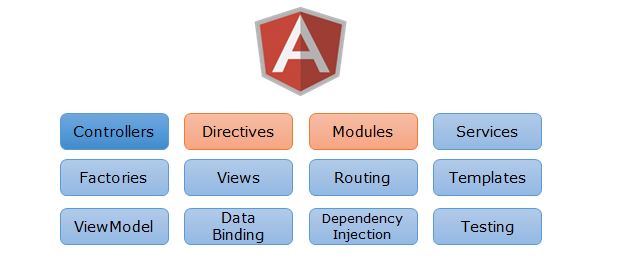Introduction to Angular JS
The development of responsive pages by extending the HTML tags and usage of dynamic functionality between the user and web application is possible with the usage of angular JS in web development. It simplifies complex application usage and automatically synchronizes with model and view by providing data manipulation. Angular JS has become one of the popular tools in the competing market for building interactive applications and developers use angular JS to bring out effective solutions to applications (KUMAWAT, SHRIVASTAVA, & PANDEY, 2024). The purpose of the report is to gain new features and components of angular JS and an understanding of its support for the development of web applications. To know the two-way binding and modular development structure. It also highlights the importance and challenges faced by the usage of angular JS and its impact on web development and frameworks.
Overview of Angular JS
Generally, the JavaScript framework which is open source helps build dynamic web applications which are all taken by Google, it uses for creating single-page applications where loading of content takes place dynamically without any need to reload of full page. Moreover, it is useful to expand the syntax of HTML and it helps the developers in creating rich robust Internet applications without any disruptions. Also, It provides clear strategies for the improvement of HTML. It helps software developers prevent challenges in developing responsive web applications (Patadiya, 2024).
Misco Hevers introduced angular JS in 2010 at Google by providing two-way binding techniques and dependency injection. It is mainly for simplification of single-page applications and concentrating on the scalability issues. So, this made the framework rewrite in angular 2. It is released in 2016 with a JavaScript-based framework. It is more suitable for web development (Dylan, 2024). New features such as routing and testing.
Main features of Angular JS
A: Two-way data binding
Two-way data binding refers to the flow of data in both directions. The changes in the model applies to the view. Angular JS manages the code and changes in data. It makes sure there are less errors in the development process. Also, it maintains the applications without any manual interventions. The data synchronizes (Bednarz, 2023). The logic is applied without manipulation. It is one of the great features of angular JS.
B: Directives
Directives is one of the key angular JS features. It is used to extend the HTML with the best attributes such as directives. It applies functionality to the applications. Various attributes use “ng” as a prefix. Firstly, Ng-app for starting the Angular JS application. Then, for initialization, ng-unit is used.Ng-model is used for defining the variables. Secondly, Ng-click is used for the evaluation of expressions or clickable elements. Later, Ng-repeat is used to define the template of each data collection. The binding of the input element takes place with ng-bind (SudheerGudapati, 2023). The values of HTML bounds using ng-model.
C: Dependency Injection
Design pattern is dependency injection used in angular JS with many components and many dependencies. The automatic injection happens with angular JS into the components to make the code easier. It maintains services and controllers that shares the resources such as services and other external services. Furthermore, better modularity with dependencies could be created. The services does not know how the dependencies are initiated. Also, It helps to request HTTP. It promotes custom services with built-in services such as $http.
D: Modules
There are various modules such as shared model, poor module, root module, and feature modules. The core modules contain components such as navigation bars, footers, and loaders. Moreover, the module makes directives and components reusable in the models. The root module is the main module where the angular module starts. The feature module helps to split the application. The user modules handle authentications and features related to the management of products. Product modules handles searches (Nintriva, 2024). Subsequently, To organize the application into manageable sessions this module benefits improved maintainability and grouping of the components for effective management and scalable applications.
E: Controllers
The controllers uses for managing the logic and view of the functions. They are useful in interactions such as clicking and submissions of any events. Additionally, It interacts with various changes in the application. Also, it contains requests of http and handle the calculations. Also, It reuses the logic across different parts of the system. The user interactions and behaviors handles with the help of linking the model and view, (Manish, 2014). Certainly, the engine controller, the main control for the scope and message is the property that holds the HTML elements. The change message is used to update the message.
Features of Angular JS

Example:
<body ng-controller=’MainApp’>
<div ng-controller=’MainCtrl’>
<div>
<input type = ‘button’ value=’Hello’ ng-click=’Hello();’/>
<input type = ‘button’ value=’World’ ng-click=’World();’/>
</div>
<div>
<p>Text: {{text}}</p>
</div>
</div>
</body>
Advantages of Angular JS
Generally, Angular JS is useful for completing dynamic experiences for single-page applications and it uses in form validations. Moreover, there are no extra usage of external libraries. Also, it gives a simpler development process and the developers understand core functionalities. The features such as two-way binding and reusable components make it easy for complex applications and data binding improves productivity by reducing errors. It develops effective code and enhances maintainability in large applications. Additionally, It gives support from Google, open-source contributions. Later, the effective solutions with the latest features updated.
Pros and Cons of Angular JS

Real-world applications of Angular JS
The mainstream video platform developed by Google is “YouTube”, it uses angular JS for backing up all the videos and getting the channels. For Example, Netflix gains many followers and there are more than 100 million. Google has used angular JS to use various applications like Google Drive to manage large data. The single-page applications such as e-commerce platforms whereas real-time updates of the products and live chats. It provides scalable applications where it automatically reflects on UI and smooth user experience and it delivers high performance by user engagement with the application.
Challenges
The steep learning curve where developers need to understand JavaScript concepts is challenging to grasp. The React JS is easy when compared with angular JS. Complicated software is difficult to manage due to the several components and libraries involved. It is also a time-consuming process to work on methodologies of angular and angular JS frameworks and it maximizes the loading time. There are many architectural challenges from shifting to Angular 2+ and there is also a skill gap. The challenge in search engine optimization whereas JavaScript took more time to load the page. Thus, Angular Universal is introduced to eliminate search inconvenience and optimize SEO rankings.
Conclusion
In Conclusion, important features such as two-way binding, dependency injection, and modular architectures. These are scalable applications to manage the complexity of the projects and with the use of directives and reusable components. Also, it increases the productivity of large-scale applications and reduces errors. Introducing the features of two-way binding has influenced web technologies with more advanced tools. In conclusion, it has improved the functionality and shaped the developers thinking with the front-end development. Furthermore, Angular JS newer version will maintain the development faster and with greater performance in building the applications and demand.
References
Bednarz, C. (2023, Jan 26). AngularJS Overview: History, Features, Alternatives, and EOL Support. Retrieved from Openlogic: https://www.openlogic.com/blog/what-is-angularjs
Dylan, A. (2024, Nov 05). The Evolution of AngularJS Development: Predictions and Trends in 2025. Retrieved from Linkedin: https://www.linkedin.com/pulse/evolution-angularjs-development-predictions-trends-2025-dylan-83pac
KUMAWAT, D., SHRIVASTAVA, V., & PANDEY, A. (2024). WEB DEVELOPMENT USING ANGULAR JS AND ITS REVIEW. International Journal of Research Publication and Reviews, 5(4), 1284-1287. Retrieved from https://ijrpr.com/uploads/V5ISSUE4/IJRPR24699.pdf
Manish. (2014, Dec 21). Getting Started With AngularJS – Controller. Retrieved from Excellencetechnologies: https://excellencetechnologies.in/blog/getting-started-angularjs-controller/
Nintriva. (2024, Mar 21). Step-by-Step Guide to Understanding Angular Modules. Retrieved from Nintriva: https://nintriva.com/blog/angular-modules/
Patadiya, J. (2024, Sep 05). What is AngularJS? A Complete Guide for Beginners to Master in 2025. Retrieved from Radixweb: https://radixweb.com/blog/what-is-angularjs
SudheerGudapati. (2023, Nov 15). Angular JS Tutorial for Beginner’s Step by Step. Retrieved from Medium: https://medium.com/@sudheer_43245/angular-js-tutorial-for-beginners-step-by-step-12e12b9c442d
Keywords
Features of Angular JS, Controllers, Web development, Directives, single-page application
Relevant Articles
Node.js and Express.js vs Python and Django
Read More about the Topic
Web Development Using Angular: A Case Study
Analysis and Research of the angularJS Framework as a Website Development Tool
